sensor JEEP WRANGLER UNLIMITED 2021 Owner handbook (in English)
[x] Cancel search | Manufacturer: JEEP, Model Year: 2021, Model line: WRANGLER UNLIMITED, Model: JEEP WRANGLER UNLIMITED 2021Pages: 330, PDF Size: 9.16 MB
Page 95 of 330
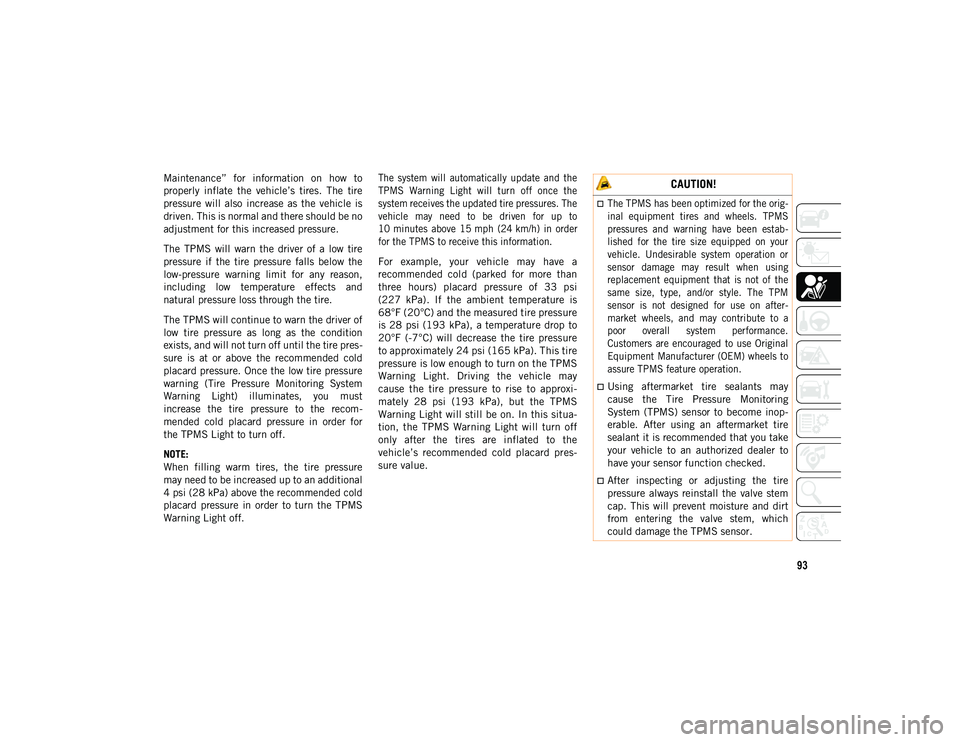
93
MaintenanceŌĆØ for information on how to
properly inflate the vehicleŌĆÖs tires. The tire
pressure will also increase as the vehicle is
driven. This is normal and there should be no
adjustment for this increased pressure.
The TPMS will warn the driver of a low tire
pressure if the tire pressure falls below the
low-pressure warning limit for any reason,
including low temperature effects and
natural pressure loss through the tire.
The TPMS will continue to warn the driver of
low tire pressure as long as the condition
exists, and will not turn off until the tire pres-
sure is at or above the recommended cold
placard pressure. Once the low tire pressure
warning (Tire Pressure Monitoring System
Warning Light) illuminates, you must
increase the tire pressure to the recom -
mended cold placard pressure in order for
the TPMS Light to turn off.
NOTE:
When filling warm tires, the tire pressure
may need to be increased up to an additional
4 psi (28 kPa) above the recommended cold
placard pressure in order to turn the TPMS
Warning Light off.
The system will automatically update and the
TPMS Warning Light will turn off once the
system receives the updated tire pressures. The
vehicle may need to be driven for up to
10 minutes above 15 mph (24 km/h) in order
for the TPMS to receive this information.
For example, your vehicle may have a
recommended cold (parked for more than
three hours) placard pressure of 33 psi
(227 kPa). If the ambient temperature is
68┬░F (20┬░C) and the measured tire pressure
is 28 psi (193 kPa), a temperature drop to
20┬░F (-7┬░C) will decrease the tire pressure
to approximately 24 psi (165 kPa). This tire
pressure is low enough to turn on the TPMS
Warning Light. Driving the vehicle may
cause the tire pressure to rise to approxi -
mately 28 psi (193 kPa), but the TPMS
Warning Light will still be on. In this situa -
tion, the TPMS Warning Light will turn off
only after the tires are inflated to the
vehicleŌĆÖs recommended cold placard pres -
sure value. CAUTION!
’ü»The TPMS has been optimized for the orig -
inal equipment tires and wheels. TPMS
pressures and warning have been estab -
lished for the tire size equipped on your
vehicle. Undesirable system operation or
sensor damage may result when using
replacement equipment that is not of the
same size, type, and/or style. The TPM
sensor is not designed for use on after -
market wheels, and may contribute to a
poor overall system performance.
Customers are encouraged to use Original
Equipment Manufacturer (OEM) wheels to
assure TPMS feature operation.
’ü»Using aftermarket tire sealants may
cause the Tire Pressure Monitoring
System (TPMS) sensor to become inop -
erable. After using an aftermarket tire
sealant it is recommended that you take
your vehicle to an authorized dealer to
have your sensor function checked.
’ü»After inspecting or adjusting the tire
pressure always reinstall the valve stem
cap. This will prevent moisture and dirt
from entering the valve stem, which
could damage the TPMS sensor.
2020_JEEP_JL_WRANGLER_UG_RHD_UK.book Page 93
Page 96 of 330
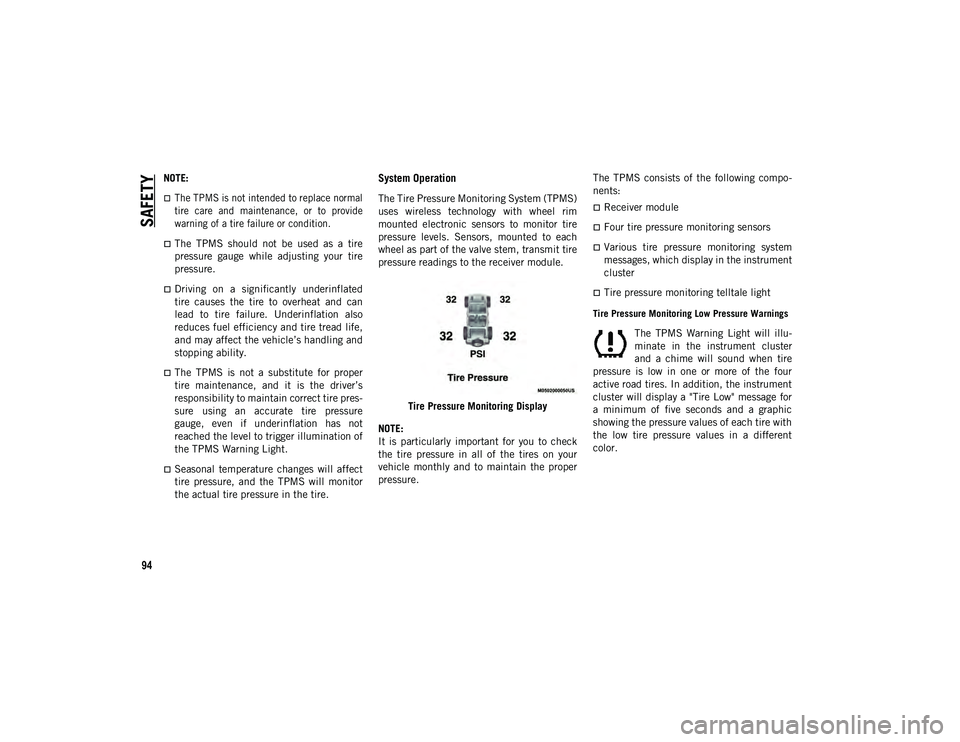
SAFETY
94
NOTE:
’ü»The TPMS is not intended to replace normal
tire care and maintenance, or to provide
warning of a tire failure or condition.
’ü»The TPMS should not be used as a tire
pressure gauge while adjusting your tire
pressure.
’ü»Driving on a significantly underinflated
tire causes the tire to overheat and can
lead to tire failure. Underinflation also
reduces fuel efficiency and tire tread life,
and may affect the vehicleŌĆÖs handling and
stopping ability.
’ü»The TPMS is not a substitute for proper
tire maintenance, and it is the driverŌĆÖs
responsibility to maintain correct tire pres-
sure using an accurate tire pressure
gauge, even if underinflation has not
reached the level to trigger illumination of
the TPMS Warning Light.
’ü»Seasonal temperature changes will affect
tire pressure, and the TPMS will monitor
the actual tire pressure in the tire.
System Operation
The Tire Pressure Monitoring System (TPMS)
uses wireless technology with wheel rim
mounted electronic sensors to monitor tire
pressure levels. Sensors, mounted to each
wheel as part of the valve stem, transmit tire
pressure readings to the receiver module.Tire Pressure Monitoring Display
NOTE:
It is particularly important for you to check
the tire pressure in all of the tires on your
vehicle monthly and to maintain the proper
pressure. The TPMS consists of the following compo
-
nents:’ü»Receiver module
’ü»Four tire pressure monitoring sensors
’ü»Various tire pressure monitoring system
messages, which display in the instrument
cluster
’ü»Tire pressure monitoring telltale light
Tire Pressure Monitoring Low Pressure Warnings
The TPMS Warning Light will illu -
minate in the instrument cluster
and a chime will sound when tire
pressure is low in one or more of the four
active road tires. In addition, the instrument
cluster will display a "Tire Low" message for
a minimum of five seconds and a graphic
showing the pressure values of each tire with
the low tire pressure values in a different
color.
2020_JEEP_JL_WRANGLER_UG_RHD_UK.book Page 94
Page 97 of 330
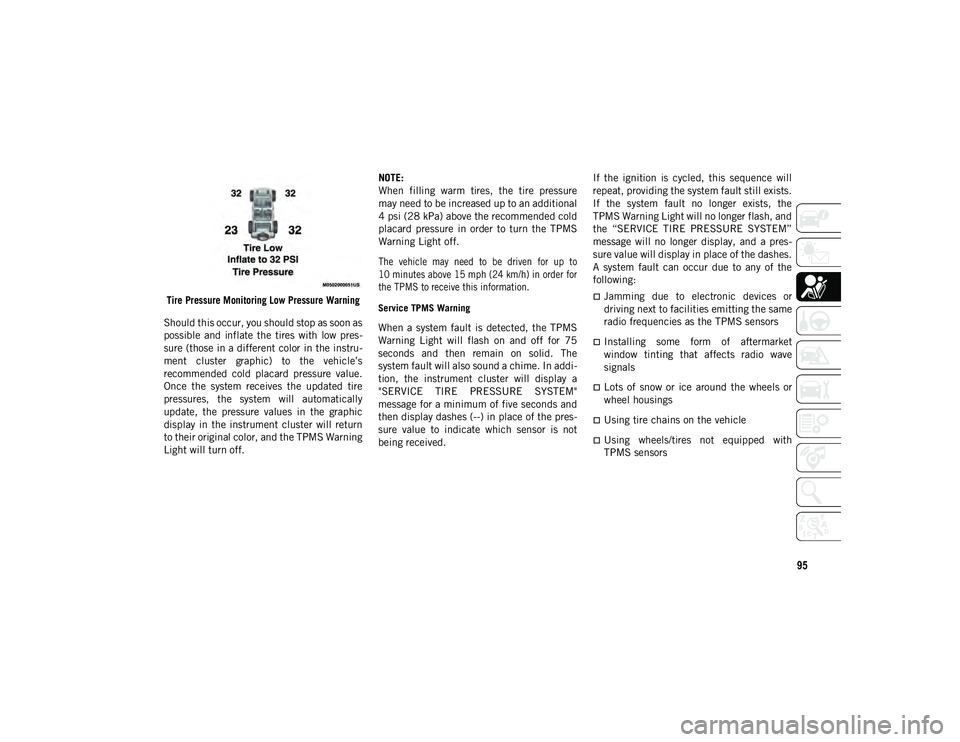
95
Tire Pressure Monitoring Low Pressure Warning
Should this occur, you should stop as soon as
possible and inflate the tires with low pres -
sure (those in a different color in the instru -
ment cluster graphic) to the vehicleŌĆÖs
recommended cold placard pressure value.
Once the system receives the updated tire
pressures, the system will automatically
update, the pressure values in the graphic
display in the instrument cluster will return
to their original color, and the TPMS Warning
Light will turn off. NOTE:
When filling warm tires, the tire pressure
may need to be increased up to an additional
4 psi (28 kPa) above the recommended cold
placard pressure in order to turn the TPMS
Warning Light off.
The vehicle may need to be driven for up to
10 minutes above 15 mph (24 km/h) in order for
the TPMS to receive this information.
Service TPMS Warning
When a system fault is detected, the TPMS
Warning Light will flash on and off for 75
seconds and then remain on solid. The
system fault will also sound a chime. In addi
-
tion, the instrument cluster will display a
"SERVICE TIRE PRESSURE SYSTEM"
message for a minimum of five seconds and
then display dashes (--) in place of the pres -
sure value to indicate which sensor is not
being received. If the ignition is cycled, this sequence will
repeat, providing the system fault still exists.
If the system fault no longer exists, the
TPMS Warning Light will no longer flash, and
the ŌĆ£SERVICE TIRE PRESSURE SYSTEMŌĆØ
message will no longer display, and a pres
-
sure value will display in place of the dashes.
A system fault can occur due to any of the
following:
’ü»Jamming due to electronic devices or
driving next to facilities emitting the same
radio frequencies as the TPMS sensors
’ü»Installing some form of aftermarket
window tinting that affects radio wave
signals
’ü»Lots of snow or ice around the wheels or
wheel housings
’ü»Using tire chains on the vehicle
’ü»Using wheels/tires not equipped with
TPMS sensors
2020_JEEP_JL_WRANGLER_UG_RHD_UK.book Page 95
Page 98 of 330
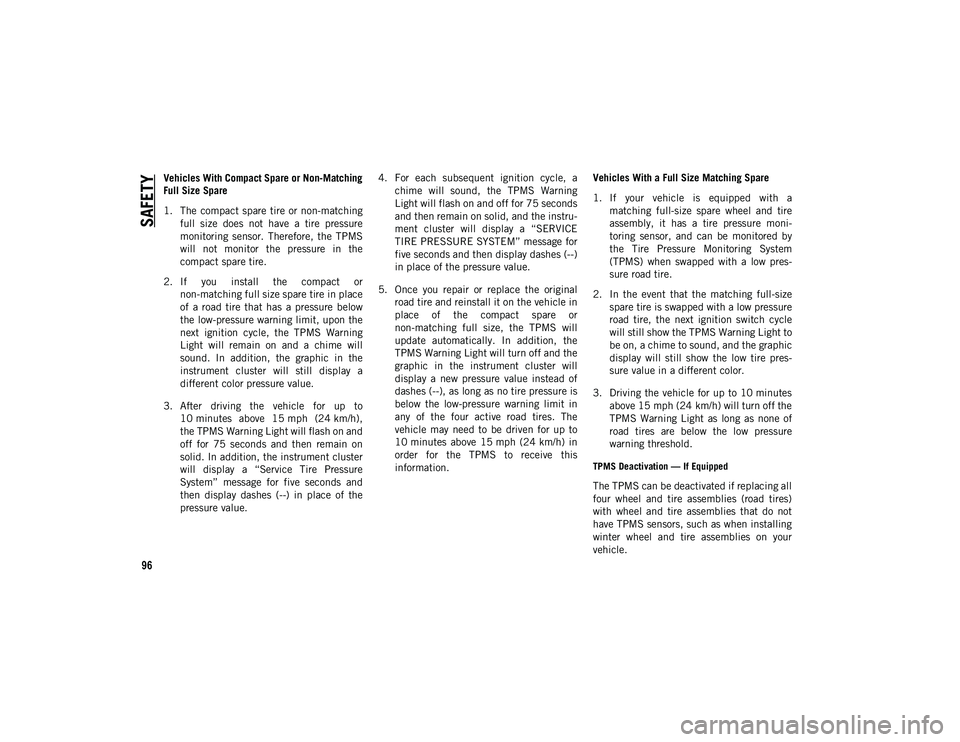
SAFETY
96
Vehicles With Compact Spare or Non-Matching
Full Size Spare
1. The compact spare tire or non-matching full size does not have a tire pressure
monitoring sensor. Therefore, the TPMS
will not monitor the pressure in the
compact spare tire.
2. If you install the compact or non-matching full size spare tire in place
of a road tire that has a pressure below
the low-pressure warning limit, upon the
next ignition cycle, the TPMS Warning
Light will remain on and a chime will
sound. In addition, the graphic in the
instrument cluster will still display a
different color pressure value.
3. After driving the vehicle for up to 10 minutes above 15 mph (24 km/h),
the TPMS Warning Light will flash on and
off for 75 seconds and then remain on
solid. In addition, the instrument cluster
will display a ŌĆ£Service Tire Pressure
SystemŌĆØ message for five seconds and
then display dashes (--) in place of the
pressure value. 4. For each subsequent ignition cycle, a
chime will sound, the TPMS Warning
Light will flash on and off for 75 seconds
and then remain on solid, and the instru -
ment cluster will display a ŌĆ£SERVICE
TIRE PRESSURE SYSTEMŌĆØ message for
five seconds and then display dashes (--)
in place of the pressure value.
5. Once you repair or replace the original road tire and reinstall it on the vehicle in
place of the compact spare or
non-matching full size, the TPMS will
update automatically. In addition, the
TPMS Warning Light will turn off and the
graphic in the instrument cluster will
display a new pressure value instead of
dashes (--), as long as no tire pressure is
below the low-pressure warning limit in
any of the four active road tires. The
vehicle may need to be driven for up to
10 minutes above 15 mph (24 km/h) in
order for the TPMS to receive this
information. Vehicles With a Full Size Matching Spare
1. If your vehicle is equipped with a
matching full-size spare wheel and tire
assembly, it has a tire pressure moni -
toring sensor, and can be monitored by
the Tire Pressure Monitoring System
(TPMS) when swapped with a low pres -
sure road tire.
2. In the event that the matching full-size spare tire is swapped with a low pressure
road tire, the next ignition switch cycle
will still show the TPMS Warning Light to
be on, a chime to sound, and the graphic
display will still show the low tire pres -
sure value in a different color.
3. Driving the vehicle for up to 10 minutes above 15 mph (24 km/h) will turn off theTPMS Warning Light as long as none of
road tires are below the low pressure
warning threshold.
TPMS Deactivation ŌĆö If Equipped
The TPMS can be deactivated if replacing all
four wheel and tire assemblies (road tires)
with wheel and tire assemblies that do not
have TPMS sensors, such as when installing
winter wheel and tire assemblies on your
vehicle.
2020_JEEP_JL_WRANGLER_UG_RHD_UK.book Page 96
Page 99 of 330
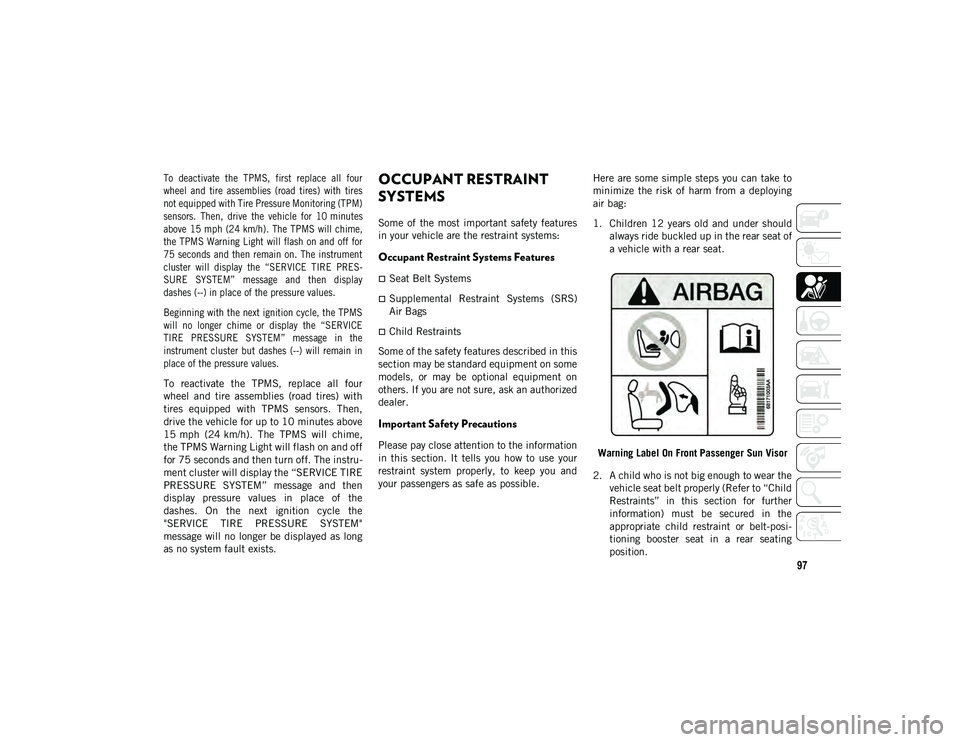
97
To deactivate the TPMS, first replace all four
wheel and tire assemblies (road tires) with tires
not equipped with Tire Pressure Monitoring (TPM)
sensors. Then, drive the vehicle for 10 minutes
above 15 mph (24 km/h). The TPMS will chime,
the TPMS Warning Light will flash on and off for
75 seconds and then remain on. The instrument
cluster will display the ŌĆ£SERVICE TIRE PRES-
SURE SYSTEMŌĆØ message and then display
dashes (--) in place of the pressure values.
Beginning with the next ignition cycle, the TPMS
will no longer chime or display the ŌĆ£SERVICE
TIRE PRESSURE SYSTEMŌĆØ message in the
instrument cluster but dashes (--) will remain in
place of the pressure values.
To reactivate the TPMS, replace all four
wheel and tire assemblies (road tires) with
tires equipped with TPMS sensors. Then,
drive the vehicle for up to 10 minutes above
15 mph (24 km/h). The TPMS will chime,
the TPMS Warning Light will flash on and off
for 75 seconds and then turn off. The instru -
ment cluster will display the ŌĆ£SERVICE TIRE
PRESSURE SYSTEMŌĆØ message and then
display pressure values in place of the
dashes. On the next ignition cycle the
"SERVICE TIRE PRESSURE SYSTEM"
message will no longer be displayed as long
as no system fault exists.OCCUPANT RESTRAINT
SYSTEMS
Some of the most important safety features
in your vehicle are the restraint systems:
Occupant Restraint Systems Features
’ü»Seat Belt Systems
’ü»Supplemental Restraint Systems (SRS)
Air Bags
’ü»Child Restraints
Some of the safety features described in this
section may be standard equipment on some
models, or may be optional equipment on
others. If you are not sure, ask an authorized
dealer.
Important Safety Precautions
Please pay close attention to the information
in this section. It tells you how to use your
restraint system properly, to keep you and
your passengers as safe as possible. Here are some simple steps you can take to
minimize the risk of harm from a deploying
air bag:
1. Children 12 years old and under should
always ride buckled up in the rear seat of
a vehicle with a rear seat.
Warning Label On Front Passenger Sun Visor
2. A child who is not big enough to wear the vehicle seat belt properly (Refer to ŌĆ£Child
RestraintsŌĆØ in this section for further
information) must be secured in the
appropriate child restraint or belt-posi -
tioning booster seat in a rear seating
position.
2020_JEEP_JL_WRANGLER_UG_RHD_UK.book Page 97
Page 106 of 330
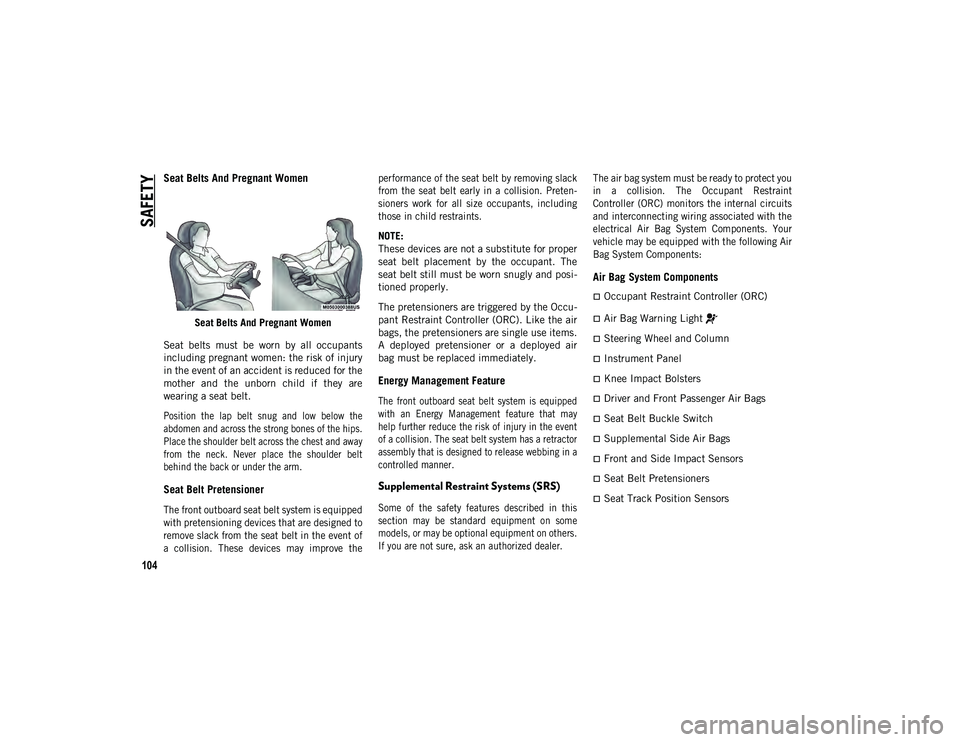
SAFETY
104
Seat Belts And Pregnant Women
Seat Belts And Pregnant Women
Seat belts must be worn by all occupants
including pregnant women: the risk of injury
in the event of an accident is reduced for the
mother and the unborn child if they are
wearing a seat belt.
Position the lap belt snug and low below the
abdomen and across the strong bones of the hips.
Place the shoulder belt across the chest and away
from the neck. Never place the shoulder belt
behind the back or under the arm.
Seat Belt Pretensioner
The front outboard seat belt system is equipped
with pretensioning devices that are designed to
remove slack from the seat belt in the event of
a collision. These devices may improve the performance of the seat belt by removing slack
from the seat belt early in a collision. Preten
-
sioners work for all size occupants, including
those in child restraints.
NOTE:
These devices are not a substitute for proper
seat belt placement by the occupant. The
seat belt still must be worn snugly and posi -
tioned properly.
The pretensioners are triggered by the Occu -
pant Restraint Controller (ORC). Like the air
bags, the pretensioners are single use items.
A deployed pretensioner or a deployed air
bag must be replaced immediately.
Energy Management Feature
The front outboard seat belt system is equipped
with an Energy Management feature that may
help further reduce the risk of injury in the event
of a collision. The seat belt system has a retractor
assembly that is designed to release webbing in a
controlled manner.
Supplemental Restraint Systems (SRS)
Some of the safety features described in this
section may be standard equipment on some
models, or may be optional equipment on others.
If you are not sure, ask an authorized dealer.
The air bag system must be ready to protect you
in a collision. The Occupant Restraint
Controller (ORC) monitors the internal circuits
and interconnecting wiring associated with the
electrical Air Bag System Components. Your
vehicle may be equipped with the following Air
Bag System Components:
Air Bag System Components
’ü»Occupant Restraint Controller (ORC)
’ü»Air Bag Warning Light
’ü»Steering Wheel and Column
’ü»Instrument Panel
’ü»Knee Impact Bolsters
’ü»Driver and Front Passenger Air Bags
’ü»Seat Belt Buckle Switch
’ü»Supplemental Side Air Bags
’ü»Front and Side Impact Sensors
’ü»Seat Belt Pretensioners
’ü»Seat Track Position Sensors
2020_JEEP_JL_WRANGLER_UG_RHD_UK.book Page 104
Page 108 of 330
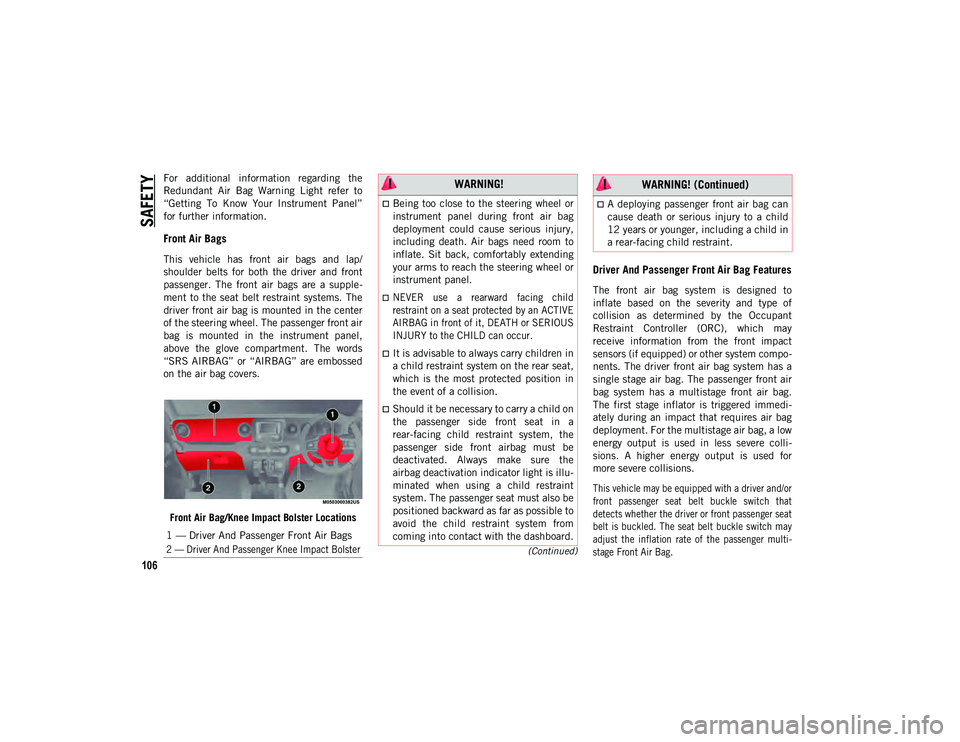
SAFETY
106
(Continued)
For additional information regarding the
Redundant Air Bag Warning Light refer to
ŌĆ£Getting To Know Your Instrument PanelŌĆØ
for further information.
Front Air Bags
This vehicle has front air bags and lap/
shoulder belts for both the driver and front
passenger. The front air bags are a supple-
ment to the seat belt restraint systems. The
driver front air bag is mounted in the center
of the steering wheel. The passenger front air
bag is mounted in the instrument panel,
above the glove compartment. The words
ŌĆ£SRS AIRBAGŌĆØ or ŌĆ£AIRBAGŌĆØ are embossed
on the air bag covers.
Front Air Bag/Knee Impact Bolster LocationsDriver And Passenger Front Air Bag Features
The front air bag system is designed to
inflate based on the severity and type of
collision as determined by the Occupant
Restraint Controller (ORC), which may
receive information from the front impact
sensors (if equipped) or other system compo -
nents. The driver front air bag system has a
single stage air bag. The passenger front air
bag system has a multistage front air bag.
The first stage inflator is triggered immedi -
ately during an impact that requires air bag
deployment. For the multistage air bag, a low
energy output is used in less severe colli -
sions. A higher energy output is used for
more severe collisions.
This vehicle may be equipped with a driver and/or
front passenger seat belt buckle switch that
detects whether the driver or front passenger seat
belt is buckled. The seat belt buckle switch may
adjust the inflation rate of the passenger multi -
stage Front Air Bag.
1 ŌĆö Driver And Passenger Front Air Bags
2 ŌĆö Driver And Passenger Knee Impact Bolster
WARNING!
’ü»Being too close to the steering wheel or
instrument panel during front air bag
deployment could cause serious injury,
including death. Air bags need room to
inflate. Sit back, comfortably extending
your arms to reach the steering wheel or
instrument panel.
’ü»NEVER use a rearward facing child
restraint on a seat protected by an ACTIVE
AIRBAG in front of it, DEATH or SERIOUS
INJURY to the CHILD can occur.
’ü»It is advisable to always carry children in
a child restraint system on the rear seat,
which is the most protected position in
the event of a collision.
’ü»Should it be necessary to carry a child on
the passenger side front seat in a
rear-facing child restraint system, the
passenger side front airbag must be
deactivated. Always make sure the
airbag deactivation indicator light is illu
-
minated when using a child restraint
system. The passenger seat must also be
positioned backward as far as possible to
avoid the child restraint system from
coming into contact with the dashboard.
’ü»A deploying passenger front air bag can
cause death or serious injury to a child
12 years or younger, including a child in
a rear-facing child restraint.
WARNING! (Continued)
2020_JEEP_JL_WRANGLER_UG_RHD_UK.book Page 106
Page 109 of 330
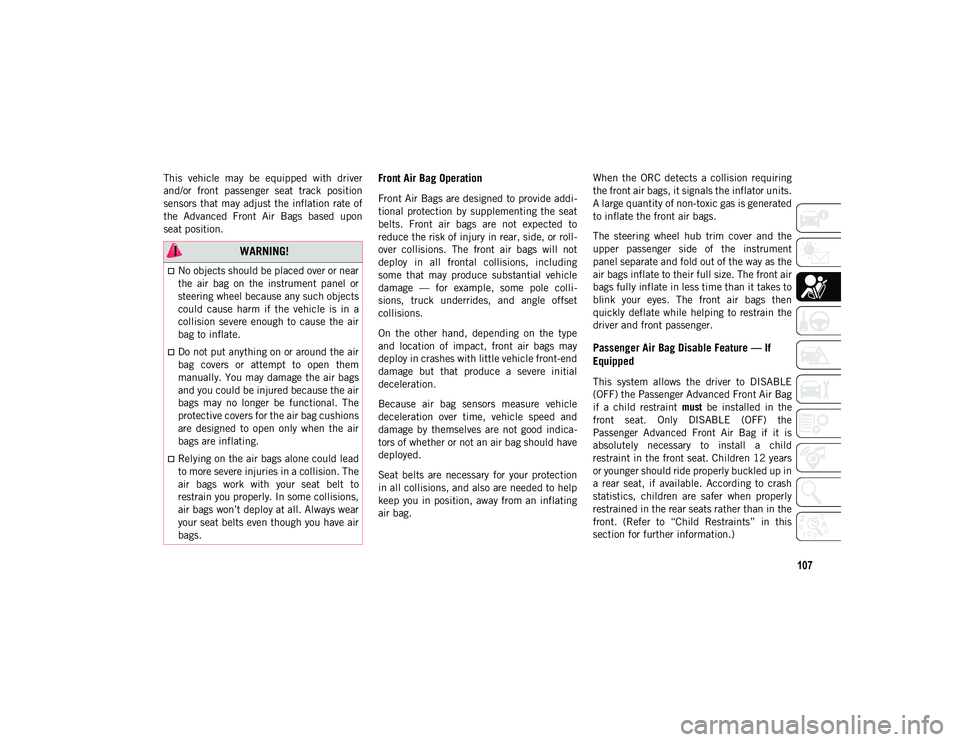
107
This vehicle may be equipped with driver
and/or front passenger seat track position
sensors that may adjust the inflation rate of
the Advanced Front Air Bags based upon
seat position.Front Air Bag Operation
Front Air Bags are designed to provide addi-
tional protection by supplementing the seat
belts. Front air bags are not expected to
reduce the risk of injury in rear, side, or roll -
over collisions. The front air bags will not
deploy in all frontal collisions, including
some that may produce substantial vehicle
damage ŌĆö for example, some pole colli -
sions, truck underrides, and angle offset
collisions.
On the other hand, depending on the type
and location of impact, front air bags may
deploy in crashes with little vehicle front-end
damage but that produce a severe initial
deceleration.
Because air bag sensors measure vehicle
deceleration over time, vehicle speed and
damage by themselves are not good indica -
tors of whether or not an air bag should have
deployed.
Seat belts are necessary for your protection
in all collisions, and also are needed to help
keep you in position, away from an inflating
air bag. When the ORC detects a collision requiring
the front air bags, it signals the inflator units.
A large quantity of non-toxic gas is generated
to inflate the front air bags.
The steering wheel hub trim cover and the
upper passenger side of the instrument
panel separate and fold out of the way as the
air bags inflate to their full size. The front air
bags fully inflate in less time than it takes to
blink your eyes. The front air bags then
quickly deflate while helping to restrain the
driver and front passenger.
Passenger Air Bag Disable Feature ŌĆö If
Equipped
This system allows the driver to DISABLE
(OFF) the Passenger Advanced Front Air Bag
if a child restraint
must be installed in the
front seat. Only DISABLE (OFF) the
Passenger Advanced Front Air Bag if it is
absolutely necessary to install a child
restraint in the front seat. Children 12 years
or younger should ride properly buckled up in
a rear seat, if available. According to crash
statistics, children are safer when properly
restrained in the rear seats rather than in the
front. (Refer to ŌĆ£Child RestraintsŌĆØ in this
section for further information.)
WARNING!
’ü»No objects should be placed over or near
the air bag on the instrument panel or
steering wheel because any such objects
could cause harm if the vehicle is in a
collision severe enough to cause the air
bag to inflate.
’ü»Do not put anything on or around the air
bag covers or attempt to open them
manually. You may damage the air bags
and you could be injured because the air
bags may no longer be functional. The
protective covers for the air bag cushions
are designed to open only when the air
bags are inflating.
’ü»Relying on the air bags alone could lead
to more severe injuries in a collision. The
air bags work with your seat belt to
restrain you properly. In some collisions,
air bags wonŌĆÖt deploy at all. Always wear
your seat belts even though you have air
bags.
2020_JEEP_JL_WRANGLER_UG_RHD_UK.book Page 107
Page 115 of 330
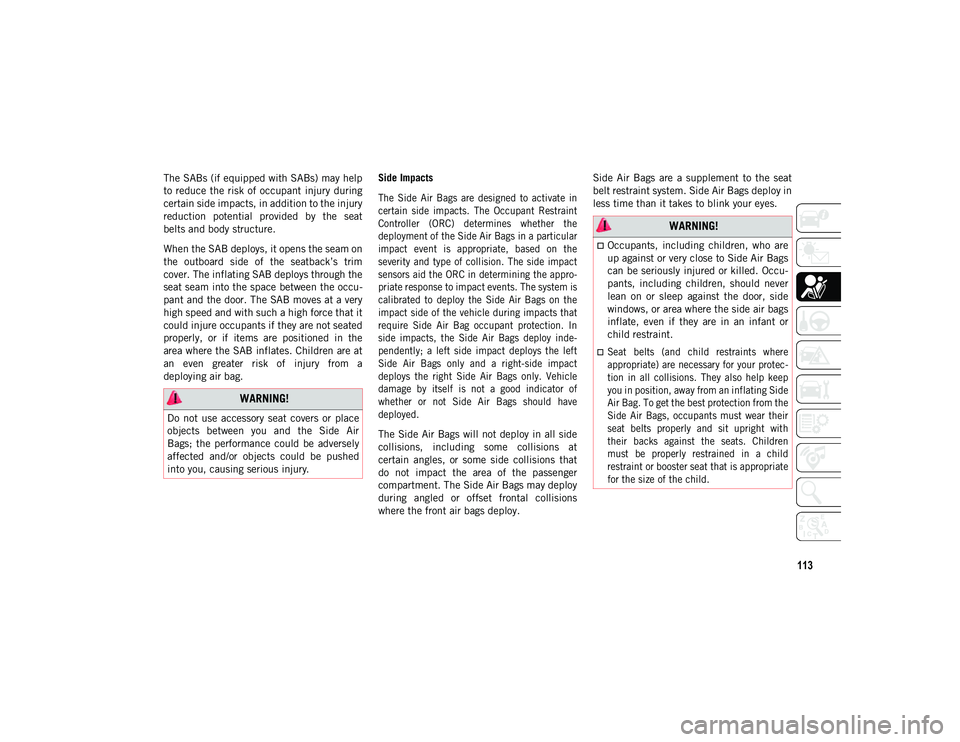
113
The SABs (if equipped with SABs) may help
to reduce the risk of occupant injury during
certain side impacts, in addition to the injury
reduction potential provided by the seat
belts and body structure.
When the SAB deploys, it opens the seam on
the outboard side of the seatbackŌĆÖs trim
cover. The inflating SAB deploys through the
seat seam into the space between the occu-
pant and the door. The SAB moves at a very
high speed and with such a high force that it
could injure occupants if they are not seated
properly, or if items are positioned in the
area where the SAB inflates. Children are at
an even greater risk of injury from a
deploying air bag. Side Impacts
The Side Air Bags are designed to activate in
certain side impacts. The Occupant Restraint
Controller (ORC) determines whether the
deployment of the Side Air Bags in a particular
impact event is appropriate, based on the
severity and type of collision. The side impact
sensors aid the ORC in determining the appro-
priate response to impact events. The system is
calibrated to deploy the Side Air Bags on the
impact side of the vehicle during impacts that
require Side Air Bag occupant protection. In
side impacts, the Side Air Bags deploy inde-
pendently; a left side impact deploys the left
Side Air Bags only and a right-side impact
deploys the right Side Air Bags only. Vehicle
damage by itself is not a good indicator of
whether or not Side Air Bags should have
deployed.
The Side Air Bags will not deploy in all side
collisions, including some collisions at
certain angles, or some side collisions that
do not impact the area of the passenger
compartment. The Side Air Bags may deploy
during angled or offset frontal collisions
where the front air bags deploy.Side Air Bags are a supplement to the seat
belt restraint system. Side Air Bags deploy in
less time than it takes to blink your eyes.
WARNING!
Do not use accessory seat covers or place
objects between you and the Side Air
Bags; the performance could be adversely
affected and/or objects could be pushed
into you, causing serious injury.
WARNING!
’ü»Occupants, including children, who are
up against or very close to Side Air Bags
can be seriously injured or killed. Occu
-
pants, including children, should never
lean on or sleep against the door, side
windows, or area where the side air bags
inflate, even if they are in an infant or
child restraint.
’ü»Seat belts (and child restraints where
appropriate) are necessary for your protec -
tion in all collisions. They also help keep
you in position, away from an inflating Side
Air Bag. To get the best protection from the
Side Air Bags, occupants must wear their
seat belts properly and sit upright with
their backs against the seats. Children
must be properly restrained in a child
restraint or booster seat that is appropriate
for the size of the child.
2020_JEEP_JL_WRANGLER_UG_RHD_UK.book Page 113
Page 116 of 330
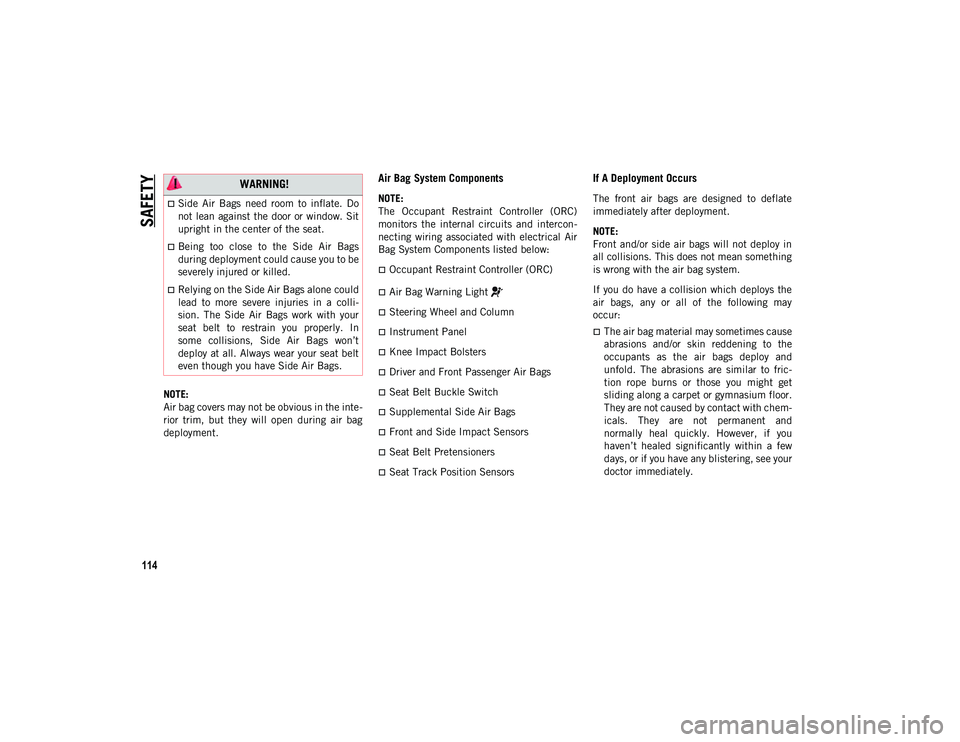
SAFETY
114
NOTE:
Air bag covers may not be obvious in the inte-
rior trim, but they will open during air bag
deployment.
Air Bag System Components
NOTE:
The Occupant Restraint Controller (ORC)
monitors the internal circuits and intercon -
necting wiring associated with electrical Air
Bag System Components listed below:
’ü»Occupant Restraint Controller (ORC)
’ü»Air Bag Warning Light
’ü»Steering Wheel and Column
’ü»Instrument Panel
’ü»Knee Impact Bolsters
’ü»Driver and Front Passenger Air Bags
’ü»Seat Belt Buckle Switch
’ü»Supplemental Side Air Bags
’ü»Front and Side Impact Sensors
’ü»Seat Belt Pretensioners
’ü»Seat Track Position Sensors
If A Deployment Occurs
The front air bags are designed to deflate
immediately after deployment.
NOTE:
Front and/or side air bags will not deploy in
all collisions. This does not mean something
is wrong with the air bag system.
If you do have a collision which deploys the
air bags, any or all of the following may
occur:
’ü»The air bag material may sometimes cause
abrasions and/or skin reddening to the
occupants as the air bags deploy and
unfold. The abrasions are similar to fric-
tion rope burns or those you might get
sliding along a carpet or gymnasium floor.
They are not caused by contact with chem -
icals. They are not permanent and
normally heal quickly. However, if you
havenŌĆÖt healed significantly within a few
days, or if you have any blistering, see your
doctor immediately.
WARNING!
’ü»Side Air Bags need room to inflate. Do
not lean against the door or window. Sit
upright in the center of the seat.
’ü»Being too close to the Side Air Bags
during deployment could cause you to be
severely injured or killed.
’ü»Relying on the Side Air Bags alone could
lead to more severe injuries in a colli -
sion. The Side Air Bags work with your
seat belt to restrain you properly. In
some collisions, Side Air Bags wonŌĆÖt
deploy at all. Always wear your seat belt
even though you have Side Air Bags.
2020_JEEP_JL_WRANGLER_UG_RHD_UK.book Page 114